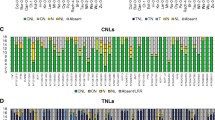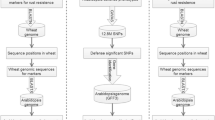Abstract
Arachis hypogaea L., commonly known as the peanut or groundnut, is an important and widespread food legume. Because the crop has a narrow genetic base, genetic diversity in A. hypogaea is low and it lacks sources of resistance to many pests and diseases. In contrast, wild diploid Arachis species are genetically diverse and are rich sources of disease resistance genes. The majority of known plant disease resistance genes encode proteins with a nucleotide binding site domain (NBS). In this study, degenerate PCR primers designed to bind to DNA regions encoding conserved motifs within this domain were used to amplify NBS-encoding regions from Arachis spp. The Arachis spp. used were A. hypogaea var. Tatu and wild species that are known to be sources of disease resistance: A. cardenasii, A. duranensis , A. stenosperma and A. simpsonii. A total of 78 complete NBS-encoding regions were isolated, of which 63 had uninterrupted ORFs. Phylogenetic analysis of the Arachis NBS sequences derived in this study and other NBS sequences from Arabidopsis thaliana, Medicago trunculata , Glycine max , Lotus japonicus and Phaseolus vulgaris that are available in public databases This analysis indicates that most Arachis NBS sequences fall within legume-specific clades, some of which appear to have undergone extensive copy number expansions in the legumes. In addition, NBS motifs from A. thaliana and legumes were characterized. Differences in the TIR and non-TIR motifs were identified. The likely effect of these differences on the amplification of NBS-encoding sequences by PCR is discussed.



Similar content being viewed by others
References
Aarts MG, te Lintel Hekkert B, Holub EB, Beynon JL, Stiekema WJ, Pereira A (1998) Identification of R-gene homologous DNA fragments genetically linked to disease resistance loci in Arabidopsis thaliana. Mol Plant-Microbe Interact 11:251–8
Adachi J, Hasegawa M (1996) Model of amino acid substitution in proteins encoded by mitochondrial DNA. J Mol Evol 42:459–468
Agrios GN (1997) Plant pathology. Academic Press, San Diego, pp 93–114
Altschul SF, Madden TL, Schaffer AA, Zhang Z, Miller W, Lipman DJ (1997) Gapped BLAST and PSI-BLAST: a new generation of protein database search programs Nucleic Acids Res 25:3389–3402
Bateman A, Birney E, Cerruti L, Durbin R, Etwiller L, Eddy SR, Griffiths-Jones S, Howe KL, Marshall M, Sonnhammer ELL (2002) The Pfam protein families database. Nucleic Acids Res 30:276–280
Bennet MD, Smith JB (1976) Nuclear DNA amounts in angiosperms. Phil Trans Royal Soc London B 274:227–274
Bertioli DJ, Schlichter UHA, Adams MJ, Burrows PR, Steinbiss H-H, Antoniw JF (1995) An analysis of differential display shows a strong bias towards high copy number mRNAs. Nucleic Acids Res 23:4520–4523
Bowles DJ (1990) Defense-related proteins in higher plants. Annu Rev Biochem 59:873–907
Cannon SB, Zhu H, Baumgarten AM, Spangler R, May G, Cook DR, Young ND (2002) Diversity, distribution, and ancient taxonomic relationships within the TIR and non-TIR NBS-LRR resistance gene subfamilies. J Mol Evol 54:548–562
Collins NC, Webb CA, Seah S, Ellis JG, Hulbert SH, Pryor A (1998) The isolation and mapping of disease resistance gene analogs in maize. Mol Plant-Microbe Interact 11:968–978
Collins N, Drake J, Ayliffe M, Sun Q, Ellis J, Hulbert S, Pryor T (1999) Molecular characterization of the maize Rp1-D rust resistance haplotype and its mutants. Plant Cell 11:1365–76
Collins N, Park R, Spielmeyer W, Ellis J, Pryor AJ (2001) Resistance gene analogs in barley and their relationship to rust resistance genes. Genome 44:375–381
Dangl JL, Jones JDG (2001) Plant pathogens and integrated defence responses to infection. Nature 411:826–833
Deslandes L, Olivier J, Theulieres F, Hirsch J, Feng DX, Bittner-Eddy P, Beynon J, Marco Y (2002) Resistance to Ralstonia solanacearum in Arabidopsis thaliana is conferred by the recessive RRS1-R gene, a member of a novel family of resistance genes. Proc Natl Acad Sci 99:2404–2409
De Wit PLGM (1995) Fungal avirulence genes and plant resistance genes: unraveling the molecular basis of gene-for-gene Interactions. Adv Bot Res 21:147–185
Donald TM, Pellerone F, Adam-Blondon AF, Bouquet A (2002) Identification of resistance gene analogs linked to a powdery mildew resistance locus in grapevine. Theor Appl Genet 104:610–618
Eddy SR (1998) Profile hidden Markov models. Bioinformatics 14:755–763
Galgaro L, Lopes CR, Gimenes M, Valls JFM, Kochert G (1997) Genetic variation between species of sections Extranervosae, Caulorrhizae, Heteranthae, and Triseminatae (genus Arachis) estimated by DNA polymorphism. Genome 41:445–454
Gassmann W, Hinsch ME, Staskawicz BJ (1999) The Arabidopsis RPS4 bacterial-resistance gene is a member of the TIR-NBS-LRR family of disease-resistance genes. Plant J 20:265–277
Halward T, Stalker T, LaRue E, Kochert G (1992) Use of single-primer DNA amplifications in genetic studies of peanut ( Arachis hypogaea L.). Plant Mol Biol 18:315–325
Hayes AJ, Saghai-Maroof MA (2000) Targeted resistance gene mapping in soybean using modified AFLPs. Theor Appl Genet 100:1279–1283
Heath MC (2000) Hypersensitive response-related death. Plant Mol Biol 44:321–34
Jones DA, Jones JDG (1997) The roles of leucine-rich repeat proteins in plant defences. Adv Bot Res 24:89–167
Kanazin V, Marek LF, Shoemaker RC (1996) Resistance gene analogs are conserved and clustered in soybean. Proc Natl Acad Sci USA 93:11746–11750
Kobe B, Deisenhofer J (1994) The leucine-rich repeat: a versatile binding motif. Trends Biochem Sci 19:415–420
Kochert G, Halward T, Branch WD, Simpson CE (1991) RFLP variability in peanut ( Arachis hypogaea L.) cultivars and wild species. Theor Appl Genet 81:563–570
Kochert G, Halward T, Stalker HT (1996) Genetic variation in peanut and its implications in plant breeding. In: Pickersgill B, Lock JM (eds) Legumes of economic importance (Advances in legume systematics, part 8). Royal Botanic Gardens Kew, London
Lawrence GJ, Finnegan EJ, Ayliffe MA, Ellis JG (1995) The L6 gene for flax rust resistance is related to the Arabidopsis bacterial resistance gene RPS2 and the tobacco viral resistance gene N. Plant Cell 7:1195–1206
Leister D, Ballvora A, Salamini F, Gebhardt C (1996) A PCR-based approach for isolating pathogen resistance genes from potato with potential for wide application in plants. Nat Genet 14:421–429
Meyers BC, Dickerman AW, Michelmore RW, Sivaramakrishnan S, Sobral BW, Young, ND (1999) Plant disease resistance genes encode members of an ancient and diverse protein family within the nucleotide-binding superfamily. Plant J 20:317–332
Meyers BC, Morgante M, Michelmore RW (2002) TIR-X and TIR-NBS proteins: two new families related to disease resistance TIR-NBS-LRR proteins encoded in Arabidopsis and other plant genomes. Plant J 32:77–92
Michelmore RW, Meyers BC (1998) Clusters of resistance genes in plants evolve by divergent selection and a birth-and-death process. Genome Res 11:1113–30
Milligan SB, Bodeau J, Yaghoobi J, Kaloshian I, Zabel P, Williamson VM (1998) The root knot nematode resistance gene Mi from tomato is a member of the leucine zipper, nucleotide binding, leucine-rich repeat family of plant genes. Plant Cell 10:1307–1319
Nelson SC, Simpson CE, Starr JL (1989) Resistance to Meloidogyne arenaria in Arachis spp. germplasm. J Nematol 21:654–660 (Suppl S)
Nicholson RL, Hammerschmidt R (1992) Phenolic compounds and their role in disease resistance. Annu Rev Phytopathol 30:369–389
Noel L, Moores TL, van der Biezen EA, Parniske M, Daniels MJ, Parker JE, Jones JDG (1999) Pronounced intraspecific haplotype divergence at the RPP5 complex disease resistance locus of Arabidopsis. Plant Cell 11:2099–2111
Notredame C, Higgins D, Heringa J (2000) T-Coffee: a novel method for multiple sequence alignments. J Mol Biol 30:205–217
Pan Q, Wendel J, Fluhr R (2000) Divergent evolution of plant NBS-LRR resistance gene homologues in dicot and cereal genomes. J Mol Evol 50:203–213
Peñuela S, Danesh D, Young ND (2002) Targeted isolation, sequence analysis, and physical mapping of nonTIR NBS-LRR genes in soybean. Theor Appl Genet 104:261–272
Peso L, Gonzalez VM, Inoharat N, Ellis RE, Nunez G (2000) Disruption of the CED-9.CED-4 complex by EGL-1 is a critical step for programmed cell death in Caenorhabditis elegans. J Biol Chem 275:27205–27211
Richly E, Kurth J, Leister D (2002) Mode of amplification and reorganisation of resistance genes during recent Arabidopsis thaliana evolution. Mol Biol Evol 19:76–84
Rogers SO, Bendich AJ (1988) Extraction of DNA from plant tissues. In: Gelvin S, Schilperoot RA (eds). Plant molecular biology manual. Kluwer Academic Press, Boston, pp A6:1-10
Ryals J, Ukness S, Ward E (1994) Systemic acquired resistance. Plant Physiol 104:1109–1112
Sambrook J, Fritsch EF, Maniatis T (1989) Molecular cloning: a laboratory manual (2nd edn). Cold Spring Harbor Laboratory Press, Cold Spring Harbor, N.Y.
Schmidt HA, Strimmer K, Vingron M, von Haeseler A (2002) TREE-PUZZLE: maximum likelihood phylogenetic analysis using quartets and parallel computing. Bioinformatics 18:502–504
Schneider TD, Stephens RM (1990) Sequence logos: a new way to display consensus sequences. Nucleic Acids Res 18:6097–6100
Schoof H, Zaccaria P, Gundlach H, Lemcke K, Rudd S, Kolesov G, Arnold R, Mewes HW, Mayer KF (2002) MIPS Arabidopsis thaliana Database (MAtDB): an integrated biological knowledge resource based on the first complete plant genome. Nucleic Acids Res 30: 91–93
Shen KA, Meyers BC, Islam-Faridi MN, Chin DB, Stelly DM, Michelmore RW (1998) Resistance gene candidates identified by PCR with degenerate oligonucleotide primers map to clusters of resistance genes in lettuce. Mol Plant-Microbe Interact 11:815–23
Simonich MT, Innes RW (1995) A disease resistance gene in Arabidopsis with specificity for the avrPph3 gene of Pseudomonas syringae pv. phaseolicola. Mol Plant-Microbe Interact 8:637–640
Simpson CE (2001) Use of wild Arachis species/introgression of genes into A. hypogaea L. Peanut Sci 28:114–116
Staden R (1996) The Staden sequence analysis package. Mol Biotechnol 5:233–241
Tameling WI, Elzinga SD, Darmin PS, Vossen JH, Takken FL, Haring MA, Cornelissen BJ (2002) The tomato R gene products I-2 and MI-1 are functional ATP binding proteins with ATPase activity. Plant Cell 14:2929–2939
The Arabidopsis Genome Initiative (2000) Analysis of the genome sequence of the flowering plant Arabidopsis thaliana. Nature 408:796–815
Thomas CM, Jones DA, Parniske M, Harrison K, Balint-Kurti PJ, Hatzixanthis K, Jones JD (1997) Characterization of the tomato Cf-4 gene for resistance to Cladosporium fulvum identifies sequences that determine recognitional specificity in Cf-4 and Cf-9. Plant Cell 9:2209–2224
Thompson JD, Gibson TJ, Plewniak F, Jeanmougin F, Higgins DG (1997) The ClustalX windows interface: flexible strategies for multiple sequence alignment aided by quality analysis tools. Nucleic Acids Res 24:4876–4882
Van der Biezen EA, Jones JDG (1998) The NB-ARC domain: a novel signaling motif shared by plant resistance gene products and regulators of cell death in animals. Curr Biol 8:R226–R227
Wang ZX, Yano M, Yamanouchi U, Iwamoto M, Monna L, Hayasaka H, Katayose Y, Sasaki T (1999) The Pib gene for rice blast resistance belongs to the nucleotide binding and leucine-rich repeat class of plant disease resistance genes. Plant J 19:55–64
Young ND (2000) The genetic architecture of resistance. Curr Opin Plant Biol 3:285–290
Yu YG, Buss GR, Maroof MA (1996) Isolation of a superfamily of candidate disease-resistance genes in soybean based on a conserved nucleotide-binding site. Proc Natl Acad Sci USA 93:11751–11756
Zhang LP, Khan A, Niño-Liu D, Foolad MR (2002) A molecular linkage map of tomato displaying chromosomal locations of resistance gene analogs based on a Lycopersicon esculentum x Lycopersicon hirsutum cross. Genome 45:133–146
Acknowledgments
The authors would like to thank Dr. José F. M. Valls for providing Arachis spp. seeds and information about the species, and Juliana G.O. Dias and Divino L. Miguel for assistance in the greenhouse. Thanks are also due to Wellington Martins and Felipe R. Silva for bioinformatics support, and to Nevin Young, Nicholas Collins and anonomous referees for helpful comments
Author information
Authors and Affiliations
Corresponding author
Additional information
Communicated by M.-A. Grandbastien
Electronic Supplementary Material
Rights and permissions
About this article
Cite this article
Bertioli, D.J., Leal-Bertioli, S.C.M., Lion, M.B. et al. A large scale analysis of resistance gene homologues in Arachis . Mol Gen Genomics 270, 34–45 (2003). https://doi.org/10.1007/s00438-003-0893-4
Received:
Accepted:
Published:
Issue Date:
DOI: https://doi.org/10.1007/s00438-003-0893-4




